|
 Tle land of Tandy is saturated with legends of Genghis Khan. The best known is one connected with lake Chagytai. Until these times, different stories circulate among the people: that Dzhagytai, either a son or grandson of Genghis Khan was executed on the lake shore, and the lake was named in his honor. But others say that Dzhagytai was the name of Genghis Khan’s daughter, a beautiful princess who died young. The Khan’s warriors dug out a huge crater. They buried the princess in the center, with inconceivable treasures next to her; then they filled the crater with water. In another version, Genghis Khan himself was buried in the vicinity of the lake. It is impossible to say which of them is closer to the truth. Let specialists decide the mystery. And you can believe the version which is closer to your heart. Tle land of Tandy is saturated with legends of Genghis Khan. The best known is one connected with lake Chagytai. Until these times, different stories circulate among the people: that Dzhagytai, either a son or grandson of Genghis Khan was executed on the lake shore, and the lake was named in his honor. But others say that Dzhagytai was the name of Genghis Khan’s daughter, a beautiful princess who died young. The Khan’s warriors dug out a huge crater. They buried the princess in the center, with inconceivable treasures next to her; then they filled the crater with water. In another version, Genghis Khan himself was buried in the vicinity of the lake. It is impossible to say which of them is closer to the truth. Let specialists decide the mystery. And you can believe the version which is closer to your heart.
Chagytai: rich, beautiful and treacherous
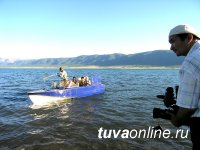 Scholars are not especially inclined to believe this kind of legends, even though they agree that the name of the lake originated in Mongolian language. However, they find it more plausible to derive it from Mongolian “zagystai”, which means “full of fish”. And really, the lake is rich in fish. For that reason it attracts law-abiding fishermen as well as devotees of illegal fishing. Currently, Chagytai has a problem with too many whitefish, which destroy the feeding base for pelyad (another fish species). To regulate the fish populations, now during the whitefish breeding season, commercial fishing is permitted. Together with fishermen who have a permit to spread their nets, poachers are successful as well; fishery inspectors ride around the lake on motorcycles, searching for tracks of the poachers. Boris Medvedev, the chief of department for protection of hunting and fishing for RT, pointed to a heaped-up pile of nets: Scholars are not especially inclined to believe this kind of legends, even though they agree that the name of the lake originated in Mongolian language. However, they find it more plausible to derive it from Mongolian “zagystai”, which means “full of fish”. And really, the lake is rich in fish. For that reason it attracts law-abiding fishermen as well as devotees of illegal fishing. Currently, Chagytai has a problem with too many whitefish, which destroy the feeding base for pelyad (another fish species). To regulate the fish populations, now during the whitefish breeding season, commercial fishing is permitted. Together with fishermen who have a permit to spread their nets, poachers are successful as well; fishery inspectors ride around the lake on motorcycles, searching for tracks of the poachers. Boris Medvedev, the chief of department for protection of hunting and fishing for RT, pointed to a heaped-up pile of nets:
- That is what we pulled out in three days…Three kilometers, seven stretches…
The poachers’ nets will be burned later.
The activities of commercial fishing have already been disrupted by private motor boats, and “scooters”, charging back and forth across the lake. People relax for three days, and fish, who have been breeding nearby, go somewhere else. Now you have to look for them.
- By the shore, for about three kilometers, water was just boiling with whitefish, - says Medvedev. They were from 3 to 10 pounds. This year, we threw a net only once, and got about a ton. But you have to prohibit the motor boats during the fishing season….
Fishermen should get 20 tons until June 30, while commercial fishing is allowed. The quota is split between UFSIN and private businessman Loginov. Medvedev has no doubts but that the quota will be reached in the specified time. The fishermen themselves say that there are “really very many” whitefish in the lake. By the shore - hundreds of tons, if not more. So far, while checking the nets, we got only two fish - but large ones.
- These are just control nets, - explains Medvedev. - They will look for another place..
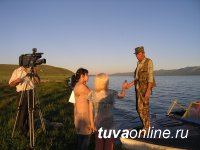 It is not possible to describe the beauty of the lake area in a few words. You have to see those shores, sometimes sandy, other places marshy with tussocks under which frogs sing their songs, and others covered with stones which hurt your feet. Reeds whisper in the winds. Moist green hilly meadows all around, and the ridge of Tannu-Ola, hovering in transparent mist of quivering heat. You have to take a boat ride, see that piercing blueness, the turquoise of Chagytai’s waves, to be in a cloud of splashes… It is not possible to describe the beauty of the lake area in a few words. You have to see those shores, sometimes sandy, other places marshy with tussocks under which frogs sing their songs, and others covered with stones which hurt your feet. Reeds whisper in the winds. Moist green hilly meadows all around, and the ridge of Tannu-Ola, hovering in transparent mist of quivering heat. You have to take a boat ride, see that piercing blueness, the turquoise of Chagytai’s waves, to be in a cloud of splashes…
The beautiful lake Chagytai with its blue waters can be also treacherous. So many fishermen and vacationers have drowned there during storms - the belief that water does not like drunks did not arise by chance. The locals say that there are deep pits in the bottom of the lake, and those who can’t swim can drown easily if they step in them. This is also used to frighten children, to keep them from getting too carried away playing in the water. The lake is up to 18-20 meters deep. That is no joke.
The lake has fresh water, because water runs through it. It is located in a depression, and is fed by waters which run off the slopes of Tannu-Ola ridge. A stream, Mazhalyk, originates in the lake, which then flows into the river Soi. Candidate of geographical sciences, Tatiana Prudnikova, who accompanied us on this trip, could not hold back from telling us about the research which she has been carrying out in these places. The scholar has been looking for connection between Shambalyg and Shambala, and attempted to prove a hypothesis that the entrance to the mythical country could very well be somewhere on Tuvan territory, quite possibly right at the confluence of these two rivers - Mazhalyk and Soi. This is evidenced by the many ritual names of objects in the locality, by the remarkable deer stone - just like the stone that , if you touch it, will transport you to Shambala, and the soil saturated with gemstones - right next to Shambalyg, there are deposits of garnets, and the multitudes of cultic and ritual places in the vicinity. All in all, the researcher explained, there is a definite connection between the names Shambalyg and Shambala: it turned out that at the location of Shambalyg, Shambalyn Datsan (monastery) stood in 18th century - one of the schools of holy Shambala.
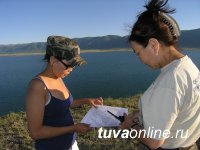 But let’s get back to the beginning. Whichever will be more attractive to tourists - Shambala, whose entrance you can seek in the valley of the little river flowing out of the lake, legends about Genghis Khan, or picturesque places - certainly, that depends on what the tour designers and those who describe the tours will emphasize. So far, Chagytai is only one among other candidates for the title of “Treasure” of the republic, and remember, there are hundreds in different districts. But let’s get back to the beginning. Whichever will be more attractive to tourists - Shambala, whose entrance you can seek in the valley of the little river flowing out of the lake, legends about Genghis Khan, or picturesque places - certainly, that depends on what the tour designers and those who describe the tours will emphasize. So far, Chagytai is only one among other candidates for the title of “Treasure” of the republic, and remember, there are hundreds in different districts.
Why Crimea? Let’s go to Dus-Khol
It would be strange if the list of the “candidates” did not include lake Dus-Khol. By the way, Svatikovo lake, as named after an enterprising salt miner, which is known not just in Tuva but beyond its borders as well, has fallen on hard times recently. The locals, who have known the lake to be larger and deeper than it is now, are anxious that Tuva could lose it irretrievably. Even though earlier it used to be supplied by three springs, now it has only two, and of those, one also almost dried out quite recently. There is no real control over the behavior of vacationers, who not just walk into the lake with buckets, dragging out water and medicinal mud, but even drive their vehicles right to the beach, and leave their garbage right there, or bury it on the beach, which is strictly forbidden. Even though scientists are not seriously concerned that taking the mud away could lead to some serious consequences destructive to the lake, it should not be done. Whether it becomes a “Treasure” of Tuva or not, the lake is in need of attention by ecological services and at the same time, of caring behavior by the visitors.
 - Dus-Khol can be totally compared to the spas of Crimea. As far as the Dead Sea goes - that is a bit of exaggeration. The salt concentration there is much higher, - Tatiana Prudnikova explains. - the healing effect of the lake is caused by the action of microelements on the organism. The water here is saturated with sodium, chlorine, and magnesium. There is lithium, iodine, cesium and bromine. Skin and joint diseases can be treated here, and the lake has also a generally fortifying effect. - Dus-Khol can be totally compared to the spas of Crimea. As far as the Dead Sea goes - that is a bit of exaggeration. The salt concentration there is much higher, - Tatiana Prudnikova explains. - the healing effect of the lake is caused by the action of microelements on the organism. The water here is saturated with sodium, chlorine, and magnesium. There is lithium, iodine, cesium and bromine. Skin and joint diseases can be treated here, and the lake has also a generally fortifying effect.
It is said that at the outset of water and mud therapy, the diseases become exacerbated, but already within a few days, a definite healing effect can be felt. Tatiana Prudnikova also explains, for those who are disgusted with the idea of bathing with others who have skin diseases, that there is nothing to be afraid of:
- The concentration of salts is so high here, that it kills all microorganisms. It has been said that not everybody can get a cure at Dus-Khol. It is true, but there is no competent explanation of this matter for a simple vacationer to find. Even surfing the Internet. Here in Tuva, there is no popular science literature about the lakes and their qualities. Those who are habituated to the products of civilization complain that at the multidisciplinary base at Dus-Khol, there are poor services, that there is no entertainment. All that will be developed, of course. But so far, the value of a vacation at Dus-Khol is specifically that you are left alone with nature and with yourself.
- The bottom of the lake is hot because of heliothermic effect, - continues to enlighten us Prudnikova. - The water is so dense and saturated with salts, that it acts as a magnifying lens on the deeper layers. They become heated by the action of solar rays. Even though there are other versions. For example, that there are hot springs somewhere there. Around here, relatively superficial deposits of coal are found, and those sometimes burn. It is possible that some underground layer is burning, and that is what heats up the lake bottom. But how about the winter, would that not keep the water hot in winter, too? The lake freezes over in the winter. Then in early spring, when the snow melts, you can find salt crystals here, of incredible size and forms. Very beautiful. You could come and film them.
 Even stronger concentration of salts is found in another, very small lake not far from Dus-Khol; its name is Kak-Khol. This lake, contrary to popular opinion, is not dead, but lives its own quiet life: it is fed by brackish ground waters. The mud of lake Kak-Khol is much stronger and more powerful than that of Dus-Khol. Even stronger concentration of salts is found in another, very small lake not far from Dus-Khol; its name is Kak-Khol. This lake, contrary to popular opinion, is not dead, but lives its own quiet life: it is fed by brackish ground waters. The mud of lake Kak-Khol is much stronger and more powerful than that of Dus-Khol.
Mysterious island
There is another “neighbor” of Dus-Khol - Khadyn - a lake with weakly saline water, composed of chloride, sulfates and magnesium, which also has a beneficial effect on human organism. This largest lake of central Tuvan depression has an attraction of its own - an island. Tatiana Prudnikova shared with us why it is so interesting. Studying aerial photos of the island, she discovered some “incomprehensible lines”. The island itself appears to be an artificial, man-made structure of heaped-up soil, as she tells us. Its origin may be connected with the Uighur epoch.
- The Uighurs used to build their castles in fortified marshy areas, so that they would be difficult to approach, - ponders Prudnikova. - For example, they could have dug out a canal to bring in drinking water, and brought the dug up earth here. That is one way this island could have been built. However, this island is of interest only to scientists. Empty curiosity will be punished by the lake itself. Chaizu Kyrgys, the leader of the management of specially protected natural territories of Tuva warned us that this is no place for the curious. You can get stuck in mud and drown.
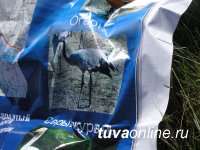 - I have never been to the island and I do not advise it to anyone, - Chaizu Suvan-oolovna is firm. - The base of the island is of mud. It is not known just how deep the mud layers are. A person and a boat can easily sink and drown there. - I have never been to the island and I do not advise it to anyone, - Chaizu Suvan-oolovna is firm. - The base of the island is of mud. It is not known just how deep the mud layers are. A person and a boat can easily sink and drown there.
Scientists call this island a “nursery” because this is the place where the “krachka” seagulls bring up their young. The birds know where to build their nests.
Speaking of Khadyn, we have to mention another subject of scientific interest. The tiny, quiet little river Khadyn, which flows into the lake from the south, and which has demonstrated its real character this year, when it flooded and destroyed the asphalt road to Bai-Khaak, may, according to scientists, also have been “created” by people. The main reason for this supposition is that the unnaturally straight course of the river is not situated, as it should be, at the bottom of the valley, but sort of hangs above the valley. The scientists admit that it is quite possible that Khadyn was a segment of some sort of a huge, therefore “fantastic” irrigation system of the ancients.
Where Genghis Khan’s carts have passed through
We got to hear another legend about Genghis Khan while on the press-tour for the “Tos Ertine” project in Tandy. This is what the elders tell children about the origin of one of the most beautiful places of the Durgen preserve and of the republic - the Durgen canyon. The story is that Genghis Khan went to conquer the forest people. Long caravans of the Khan’s heavy carts crossed over the mountain ridge. They excavated the canyon with their wheels. The legends even explain the name of the river flowing through the canyon. A young woman accompanied the Khan on his difficult journey; she was pregnant, near delivery. And right here, on the road, her labor pains started. Subotai started hurrying the people; “Durgen! Durgen!” - and the river flowing through the canyon was named after this event.
- That is what they say, - trainer of Bai-Khaak DYUSSH Oleg Kushtug-ool shrugs his shoulders; he has researched this canyon back and forth, alone and with his charges. He is the one who submitted his beloved Tandy attraction to the “Tos Ertine” contest.
He hopes, of course, that the canyon will be one of the winners. He is confident - the place has everything to develop various kinds of tourism - walking, riding on horseback and on bicycles, climbing rocks. Right next to the canyon there are wide meadows, where you can build a camp. The road to the canyon is good, and it is not far from the capital, - arguments Oleg Kuularovich.
You can even get to the place where the waterfall “lives” by car. But it is much more pleasant to walk through the taiga. The ground is covered by needles of evergreens, you walk as if on a carpet, and the air is saturated with intoxicating fragrance of the taiga. The city people could not keep from asking: what is this smell?
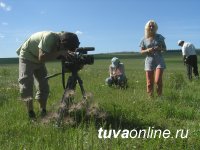 - It is the fragrance of the taiga, - smiles Lyudmila Khadzhieva, deputy of the head of the district administration, who accompanied the journalists on this press-tour. - It is the aroma of the evergreens, grasses, and Maria’s root is now in bloom as well as many other flowers. - It is the fragrance of the taiga, - smiles Lyudmila Khadzhieva, deputy of the head of the district administration, who accompanied the journalists on this press-tour. - It is the aroma of the evergreens, grasses, and Maria’s root is now in bloom as well as many other flowers.
We can hear the waterfall from a distance. Durgen runs along the bottom of the canyon, and the water falls from a height of 4 meters. It is no Niagara, but it is also beautiful. A cloud of splashes hovers above the waterfall During the day, you can see little rainbows. The depth of the ravine is 20-40 meters in various places. As you look down your head spins. It is not a simple task to descent down to the waterfall. The walls are steep, and without a rope you can fall. Down there are boulders. In July, when Durgen becomes shallower, it is possible to wade along the bottom of the canyon, and to walk up to the waterfall. It is even possible to bathe if you wish. But the water is icy. Right now, Durgen is deep and runs stormily - it is dangerous to “commune” with it.
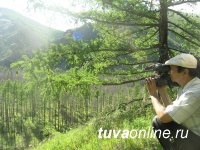 The journalists were afraid to descend into the canyon, except for the desperate filming group from the local TV - what they won’t do for a good TV film. They suggested: this place needs a rope ladder. The journalists were afraid to descend into the canyon, except for the desperate filming group from the local TV - what they won’t do for a good TV film. They suggested: this place needs a rope ladder.
Oleg Kushtug-ool, showing all this beauty to the journalists, was happy, listening to their exclamations of admiration. Then he shared his thoughts:
- We need to bring children to nature more often. Now it is prohibited to bring them to the forest. That is why we have so many bad forest fires. As the saying is, you have to keep your enemies at hand. When we go to burnt-out areas, it makes a tremendous impression on the kids. They are filled with the impression, they say oh, how horrible. The children need to actually see with their own eyes what a fire can do.
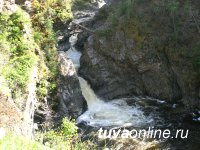 How many other new, unexpected things are hiding in Tandy? - And we thought that we knew everything about it. The district has magnificent lakes, which are really popular with locals and with visitors. If the leadership of the district starts developing a contemporary spa complex, the district could get a substantial income from it. And not just the district. As the project “Nine Treasures” shows, the tourist business, if brought to a sufficient level, could substantially increase the local income of the republic. All the natural and historical resources for it are available right here. How many other new, unexpected things are hiding in Tandy? - And we thought that we knew everything about it. The district has magnificent lakes, which are really popular with locals and with visitors. If the leadership of the district starts developing a contemporary spa complex, the district could get a substantial income from it. And not just the district. As the project “Nine Treasures” shows, the tourist business, if brought to a sufficient level, could substantially increase the local income of the republic. All the natural and historical resources for it are available right here.
|
|
